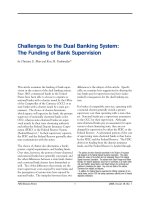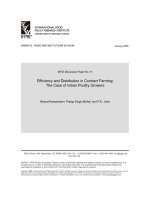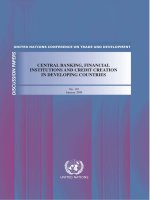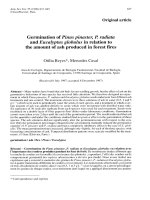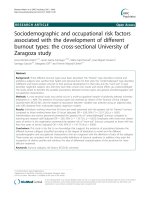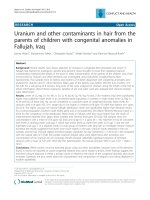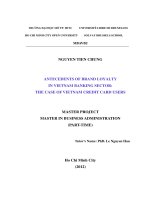Institutions and credit risk in banking system, the case of emerging economies
Bạn đang xem bản rút gọn của tài liệu. Xem và tải ngay bản đầy đủ của tài liệu tại đây (208.84 KB, 30 trang )
Policies and Sustainable Economic
Development | 505
Institutions and Credit Risk in Banking
System:
The Case of Emerging Economies
SU DINH THANH
University of Economics HCMC -
NGUYEN PHUC CANH
University of Economics HCMC -
Abstract
The extant literature has documented the determinants of bank credit risk, but
does not pay much attention to institutions. This study fills this gap by
investigating the effects of institutions on bank credit risk. Our data covers 33
emerging economies over the period of 2002 - 2013. Applying system GMM
estimator for unbalanced panel data, the study finds intriguing findings. Given
credit supply, the effects of bank liquidity and bank profitability are negative,
while the effects of bank capital and bank size and bank concentration are
significantly positive. On the other hand, in terms of credit demand the effect of
real GDP growth rate is negative. Our main finding is that institutions have
negative effects on bank credit risk. Particularly, in the present of institutions, the
interaction effects of bank liquidity, bank capital and bank size, bank profitability,
and real GDP growth rate are strengthened. These results imply that
improvements in institutions are significant for control over bank credit risk in
emerging countries.
Keywords: institution; banking system; credit risk; emerging
economies
506 | Policies and Sustainable Economic Development
1. Introduction
There has been a growing literature on determinants of bank credit risk
in the recent years, especially since the 2008 global financial crisis.
Several studies blame the crisis on excessive risk taking of banking
system (Agnello & Sousa, 2012; Hoque, Andriosopoulos, Andriosopoulos, &
Douady, 2015). A deep understanding of credit risk determinants is crucial
importance for the proper evaluation of banking system risk and has a
direct link with the development of suitable regulation and prudential
tools.
In fact, there are numerous works focusing on the determinants of credit
risk in banking system including microeconomic factors such as bank
liquidity, bank capital, bank size, bank competition, credit derivatives,
internal rating systems, collateral, relationship between lender and
customer (e.g., Imbierowicz & Rauch, 2014; Agarwal et al., 2016; De Lis et
al., 2001; Mandala et al., 2012); and macroeconomic factors such as
inflation, unemployment, house price, credit cycles, business cycle, and
economic growth (e.g., Hoque et al., 2015; Castro, 2013; Chen, 2007;
Jiménez et al., 2005; Tajik et al., 2015; Marcucci & Quagliariello, 2009;
Jiménez et al., 2005).
The credit activities of banking system are the function of the asymmetric
information problem (Lindset et al., 2014; Miller, 2015; Neyer, 2004). This
problem may be reduced if the institution of a country is improved. The
quality of institution and financial regulation are definitely determinants of
bank credit risk since the improvements in institution and financial regulation
reduce the asymmetric information problems, thus induce banking system to
provide bank loans with better quality. On the other hand, financial insurance
regulation may stimulate banks in taking more risks.
Indeed, the role of public institutions or public governance in reducing
the overall risk in the economy is explored in several studies (Cohen et al.,
1983; Dal Bó & Rossi, 2007; Dutta et al., 2013; Ho & Michaely, 1988;
Williamson, 1981). However, not much is known about public institutions
in determining credit risk in banking system in emerging countries. In
addition, the associations between public institutions and other
determinants of credit risk such as bank capital, bank liquidity, bank size,
bank competition, and economic growth are ignored.
Therefore, this study goes to fill this gap by investigating the effects of
public institutions and the associations between them with bank
characteristics including bank capital, bank liquidity, bank size, and bank
competition, which reflect the determinants of bank credit supply, on bank
credit risk. This paper is not the first to explore the determinants of credit risk
in banking system, but it is innovative in several ways. First, this is the first
study using three dimensions of public institutions including government
effectiveness, regulatory quality, and rule of law to investigate the effects of
institutional quality on credit risk in banking system in emerging countries.
Second, we use interaction terms between each institutional indicator and
bank credit supply factors in order to examine the effect of credit supply’s
determinants on bank credit risk when institutions are present. In addition, we
use interaction terms between each institutional indicator and real economic
growth in order to examine the effect of bank credit demand factors when
institutions are present. These methodologies ensure
Policies and Sustainable Economic
Development | 507
that our model catches all the main drivers of credit activities relating to
credit risk in banking system.
With these strategies, we believe that our study has significant contribution
to both scholar and practice. In fact, our empirical results show that
institutional quality has significant negative effect on credit risk in banking
system, indicating that improvements in institutions (such as government
effectiveness, rule of law, and regulatory quality) have good effects on
banking system stability and reducing systematic risk. This result has strong
contribution to the literature of institution, where the institutional quality
impacts not only on economic growth (e.g., Acemoglu & Robinson, 2008;
Dollar & Kraay, 2003; Fatás & Mihov, 2005), but also on the stabilization of
financial market. Most notably, we find that improvements in government
effectiveness and rule of law in line with the higher of liquidity, capital, size,
competition, and lower of profitability in banking system increase bank credit
risk. The interaction terms between regulatory quality with bank credit supply
characteristics have same effects as government effectiveness and rule of law
excluding the profitability and competition in banking system, which have
opposite impacts on bank credit risk. More precisely, we find that the
interaction terms between improvements in institutions with economic growth
increase bank credit risk. This results show the risk-taking activities of
banking system with higher liquidity, capital, size, competition, and lower
profitability in emerging economies in the case of better government
effectiveness and rule of law. Better regulations also simulate banks taking
more risks excluding banking system with lower profitability and higher
competition, which means that better regulations help banking system more
stabilization and more safety.
The rest of the paper proceeds as following manner. Section 2 reviews
related bank credit risk determinants through the drivers of credit demand
and credit supply. Section 3 introduces methodology and data. Section 4
presents our empirical evidences from three dimensions of institutions
including government effectiveness, rule of law, and regulatory quality.
Final section concludes.
2. Literature review
Many previous empirical studies analyze determinants of bank credit
risk or nonperforming loans, including macroeconomic factors and specific
banking sector characteristics (Castro, 2013). The bank credit risk is
generally defined as the risk that a loan is not being paid by borrowers to
bank partially or totally. The analysis of bank credit risk determinants in
banking system is essential for policy makers since it provides early alarms
for macroeconomic management in front of shocks and preventing
financial system from a possible crisis (Agnello et al., 2011; Agnello &
Sousa, 2012; Beltratti & Stulz, 2012).
In the literature, bank credit risk is divided into systematic credit risk and
unsystematic credit risk (e.g., Ahmad & Ariff, 2007; Aver, 2008; Frye et al.,
2000; Dietsch & Petey, 2002). The drivers of systematic credit risk include: (i)
macroeconomic factors such as unemployment, economic growth,
508 | Policies and Sustainable Economic Development
inflation, and exchange rate; (ii) changes in economic policies such as
monetary policy, fiscal policy, economic legislation changes, or trade policy,
(iii) and political changes. These factors may influence the probability of
borrowers paying their loans. For instance, Aver (2008) finds that
employment, long-term interest rates, and the value of stock market have
important impacts on credit risk of the Slovenian banking loan portfolio. Kattai
(2010) and Fainstein and Novikov (2011) show that banking systems highlight
the importance of economic growth in Estonia, Latvia, and Lithuania. Salas
and Saurina (2002) and Jakubík (2007) also point out that GDP growth and
interest rates are the main macroeconomic factors affecting bank credit risk
for the Spanish and Czech, respectively.
The divers of unsystematic credit risk includes: (i) the factors related to
borrowers such as personality, financial solvency, and capital of
individuals; (ii) management, financial position, sources of funds, and
financial reporting, and specific factors of the industry sector of firms
(Castro, 2013). Zribi and Boujelbène (2011) studies ten commercial banks
in Tunisia over the period 1995-2008 by estimating a panel model
controlling for random effects find that ownership structure, prudential
regulation of capital, profitability are main drivers of bank credit risk.
Furthermore, Ahmad and Ariff (2007) point out the importance of micro
characteristics from commercial banks of some emerging and developed
economies on the bank credit risk including regulatory capital and
management quality. Meanwhile, Jiménez and Saurina (2004) use data
from several Spanish credit institutions to investigate the role of collateral,
type of lender, bank-borrower relationship, and the effects of
characteristics of the borrowers and of the loan on bank credit risk. They
find that collateralized loans have a higher probability of default, and that
while loans granted by savings banks are riskier, a close bank-borrower
relationship increases the willingness for risk-taking behavior of banks.
Nevertheless, there is a multitude of empirical studies looking at main
drivers of bank credit risk and highlighting that macroeconomic and
microeconomic variables should be included into the analysis due to their
considerable influence. The vast majority of these empirical works consider
the macroeconomic and microeconomic factors as the most important drivers
in the determinants of bank credit risk based on a single country analysis.
Some provide a multi-country comparative analysis without concerning to the
effects of institution and its associations with microeconomic factors and
macroeconomic factors. In this study, we inspect the determinants of credit
risk in banking system under the aspects of credit supply and credit demand
factors to better understanding the influence of institution on credit function
and risk-taking behavior of overall banking system.
The institution of a country which is defined as the rules of the game in
a society (North, 1990), includes three features: (i) “humanly devised”
which contrasts with other economic fundamentals;
(ii) “the rules of the game” to set “constraints” on human behavior; and
(iii) their major effect will be through incentives (see North, 1981;
Acemoglu & Robinson, 2008). Several works have studies the effects of
institution, which is named as the new institutional economics, but the
effects of institution on credit risk in banking system are still ignored.
Therefore, we try to build our arguments to explain for this issue by four
directions.
Policies and Sustainable Economic
Development | 509
First, better institutional quality induces higher economic growth, and then
reduces credit risk in banking system. In the literature of economic growth,
institution is considered the differences in residuals of economic growth.
Previous studies agree that better institutional quality is positively and
significantly correlated with economic growth (Young & Sheehan, 2014). For
instance, Djankov et al. (2002) finds that the lower cost of opening a mediumsize business in the United States in comparison with Nigeria, Kenya, Ecuador,
and Dominican Republic is highly correlated with economic growth.
Meanwhile, Beekman et al. (2014) find that corruption reduces incentives of
individuals in both voluntary contributions and investments in Liberia, and
thus impacts on economic growth. Therefore, better institutional quality will
be in line with higher economic growth and hence improving the financial
situation of borrowers and reducing credit risk in banking system.
Second, better institutional quality reduces asymmetric information
problems (Cohen et al., 1983; Ho & Michaely, 1988; Williamson, 1981);
hence, banks will be less probability of making wrong decisions in lending
to bad borrowers.
Third, better institutional quality reduces overall risk in the economy
(Cohen et al., 1983; Ho & Michaely, 1988; Williamson, 1981), thereby
inducing a lower systematic risk and reducing credit risk of bank credit
portfolio. In fact, better institutional quality helps economic agents more
trustable in business transactions. Thus, institutional quality positively
impacts the efficiency of businesses (Dal Bó & Rossi, 2007), and mitigates
systematic risk in overall economy. Dutta et al. (2013) find that worse
corruption situation leads to high inequality, poverty, and employment and
thus undermines the effectiveness of economic growth in India.
Four, better institutional quality reduces transaction cost in economic
activities in general and credit activities in particularly. As a result, better
institutional quality induces higher efficiency of credit activities and better
control of credit risk in banking system.
Although the views of systematic and unsystematic credit risk dominate
in the literature of bank credit risk, we can examine the determinants of
credit risk in banking system under the basic determinants on demand and
supply sides of credit function. The approach of the systematic and
unsystematic credit risk is suitable for bank level studies due to defining
factors relating to systematic or unsystematic risk, but the approach of
determining the drivers of credit risk from the views of supply and demand
side in credit function is better at the banking system level or country
level, since it is easy to define the drivers of credit risk in the overall
banking system.
In the literature, the function of credit is impacted by supply and
demand side factors. On the demand side, income level and growth rate of
GDP per capita are main determinants of credit demand (Backé & Wójcik,
2008). For instance, Duprey (2012) uses real GDP growth in explaining the
different pattern of bank behaviors over macroeconomic fluctuations at
459 public banks in 93 countries. Similarly, Elekdag and Han (2015) find
that domestic factors such as economic growth and monetary policy
shocks are more dominant than external factors in driving rapid credit
growth in emerging Asia.
510 | Policies and Sustainable Economic Development
Indeed, economic growth increases the expected income and profit in line
with better financial conditions of private sector, thus allowing for higher
levels of indebtedness (Kiss, et al., 2006), while households may want to
increase debt levels to smooth consumption in current time since they expect
higher income in the future (Backé & Wójcik, 2008). In addition, higher
economic growth increases the disposable income of people and thus
stimulates them in consumption and investment. Firms are also induced to
expand their operations to catch up with increasing demand, thereby
stimulating the increased credit demand. Even though the profit of firms may
be higher due to economic growth, thus stimulating them to rely more on
internal funds instead of bank loans (Kiss et al., 2006), this effect may be not
strong as the positive effects of economic growth on credit demand in
developing or emerging economies since high economic growth needs a
bundle of capital.
Accordingly, fluctuations in economic growth definitely change credit
demand and then, in turn, impact on credit risk in banking system, which
explains the relation between credit risk and business cycle (Marcucci &
Quagliariello, 2009). For example, using lagged percentage change in GDP
to explain for the banking crisis in the Nordic countries in the period of
1980s-1990s, Pesola (2001) finds that the shortfalls of GDP growth below
forecast contribute to their banking crises. Salas and Saurina (2002) finds
that the GDP growth rate in line with other microeconomic factors such as
firms, and family indebtedness, rapid past credit or branch expansion,
inefficiency, portfolio composition, size, net interest margin, capital ratio,
and market power are drivers of credit risk in Spanish commercial and
savings banks in the period 1985-1997. Meyer and Yeager (2001) and
Gambera (2000) find that macroeconomic variables are good predictors
for the non-performing loans in the US. Marcucci and Quagliariello (2008)
use data from Italian banks and find that the credit risk is increased in
economic downturns. Similarly, Hoggarth et al. (2005) provide the same
evidence for the case of the UK.
There are some possible explanations to the cyclicality of credit risk such
as disaster myopia, over-optimism, herd behaviors, and insufficient market
disciplines (Marcucci & Quagliariello, 2008). Marcucci and Quagliariello (2008)
verify the cyclicality of credit risk from the following perspectives: (i)
economic growth increases the profit of firm, which raises asset prices rise
and customers’ expectations at the beginning of expansionary phase and
then increases aggregate demand. As a result, the increasing of aggregate
demand induces a rapid growth in bank credit portfolio and in economy's
indebtedness, where banks usually underestimate their risk exposure and
relax their credit standards due to over-optimism in the increasing of credit
demand, which causes the deterioration of borrowers’ creditworthiness; and
(ii) customers’ profitability will be worsened when an exogenous shock
occurs. The over-optimism is likely to become over-pessimism that can trigger
the pitfall of asset prices and worsens customers’ financial wealth depressing
deeper, while the downturn in asset prices worsens the value of collaterals of
banking system. Therefore, non-performing assets emerge, while firms’
financial distress increases, causing losses in banks’ balance sheets, and thus
both banks’ profitability and capital adequacy deteriorate consequently as
cyclicality.
Policies and Sustainable Economic
Development | 511
In fact, the effect of economic growth on credit risk in banking system
follows the explanations of over-optimism, herd behaviors, and insufficient
market disciplines, which depend much on institutional environment of a
country. Since better institutional quality reduces asymmetric information
problems, transaction cost, and risk, while improving the efficiency of
asset allocations, and property right protection (Cohen et al., 1983; Ho &
Michaely, 1988; Williamson, 1981), better institution in association with
higher economic growth may stretch cyclicality of credit risk in banking
system under the impact of risk-taking behavior of banks.
The literature of banking activities have concluded that there are many
determinants of bank risk-taking behavior such as capital requirement,
bank size, bank leverage and financial liberalization (Ashraf et al., 2016;
Bhagat et al., 2015; Blaško & Sinkey Jr., 2006; Borio & Zhu, 2012; Cubillas
& González, 2014; Efing et al., 2015; Galloway et al., 1997; García-Marco &
Robles-Fernández, 2008). Ashraf et al. (2016) find strong evidence that
bank risk-taking is significantly higher in countries, which have high
individualism, low uncertainty avoidance, and low power distance cultural
values. Buch and DeLong (2008) examine cross-border bank mergers and
find that the supervisory structures of the partners’ countries influence
changes in post-merger total risk and strong host regulators limiting the
risky activities of their local banks.
As a summary, the higher economic growth makes both people and
banks more confidence and more optimistic, while better institutional
quality boosts this confidence and optimistic higher due to better quality
of government, regulation, law system, property right protection, and also
reduces corruption problem, therefore banks may take riskier activities in
their credit portfolio. Therefore, we argue that better institutional quality in
line with higher economic growth will simulate risk-taking activities of
banks, hence increasing the credit risk of overall banking system.
On the supply side, banks are assumed to make decisions on their credit
portfolios depending on all available information and their internal financial
conditions such as capital, liquidity, profitability, assets, therefore these
internal characteristics of banks have strong impacts on credit risk. The
extent literature has examined the drivers of credit supply of banks (Auel & de
Mendonça, 2011; Aysun, 2016; Bhaumik et al., 2011; Ciccarelli et al., 2015;
Liu & Minford, 2014; Ramos-Tallada, 2015; Yagihashi, 2011). Marcucci and
Quagliariello (2008), for instance, document that banks may react stronger to
external shocks such as recession in economy by cutting their credit supply
higher if they face to constraints such as capital in their balance sheet. While,
Bernanke and Gertler (1995) argue that banks can adjust their credit supply in
responding with external shocks such as a contractionary or expansionary
monetary policy, where a contractionary monetary policy leads to a
decreasing in available fund such as deposits or other funds, and thus banks
have to reduce their credit portfolio.
Many empirical studies show that banks may not response to external
shocks in the line of what the authorizers want in some cases. For instance,
banks may do risk-taking activities by increasing their credit supply despite
contractionary monetary policy (Angeloni et al., 2015; Buch et al., 2014; de
Moraes et al., 2016; DellʼAriccia et al., 2014; García-Kuhnert et al., 2015;
Montes & Peixoto, 2014).
512 | Policies and Sustainable Economic Development
Particularly, studies on credit channel argue that the actions of banks in
their credit portfolio depend on their internal conditions including capital,
liquidity, size, profitability, and competition on banking sector (Aiyar et al.,
2016; Aysun, 2016; Gunji & Yuan, 2010; Imbierowicz & Rauch, 2014; Khan
et al., 2016; Leon, 2015; Yang & Shao, 2016).
There is usually an adequate requirement in the minimum capital ratio that
every bank needs to meet. Whenever, there is an external shock such as a
downturn in economic growth or a contractionary monetary policy, banks with
lower capital buffers above the minimum capital requirement will reduce their
credit supply much more (Bliss & Kaufman, 2002). If firms cannot substitute
bank loans by other sources, they may face to insufficient funding for their
investment projects, and in turn, increasing the credit risk of banks. Hence,
banks with higher capital will be less credit risk. But, banks with lower capital
ratio have to raise additional capital before expanding credit to bind riskbased capital requirement, thus they may optimally forgo profitable loans to
reduce the risk of future capital inadequacy (Van den Heuvel, 2002). As a
result, they may choose to reject bad projects for lending to reduce credit
risk. Konishi and Yasuda (2004) find that the implementation of the capital
adequacy requirement reduces risk taking at Japanese commercial banks,
while banks with higher capital ratio may take riskier activities for higher
profits, leading to increasing credit risk.
The liquidity is also very important for banking system due to the risk of
bankruptcy (Diamond
& Rajan, 1999; Gatev et al., 2009; Imbierowicz & Rauch, 2014). In fact,
banks have to consider their liquidity situation when they make credit
decisions. Banks with higher liquidity may be more flexible in supplying
their credit portfolio, thus they are better management their credit risk.
However, higher liquidity may simulate banks taking risk in their credit
activities such as the studies of Nguyen and Boateng (2013) and Nguyen
et al. (2015).
The size of bank is usually mentioned as the main driver of credit risk
(Demsetz & Strahan, 1997; Kishan & Opiela, 2000). At bank level, larger
banks have higher market power and thus they have higher advantages in
managing their credit portfolio, while smaller banks may take risk due to
lower market share. However, larger banks may be impacted by the
theory “too big to fail” (O'hara & Shaw, 1990; Papachristos, 2011); thus,
they take more risk-taking activities than smaller ones and have higher
credit risk (Bhagat et al., 2015; Chen et al., 2015; Hakenes & Schnabel,
2011; Stever, 2007). At country level, larger banking system measuring
under the relative size of assets in banking system with GDP defines the
higher domination of banks in financial system and the more importance
of their role in the economy, which creates more incentives for banks in
taking risk due to the higher probability of government in intervening
whenever they face to financial distress to protect people from panic as
theory of “too big to fail”.
At the last characteristic mentioned in our arguments, the profitability of
banks measured by return on asset or return on equity may have
goodness on bank credit risk. The higher profitability of banks makes them
more flexible in managing their credit portfolio, and also reduce pressures
in
Policies and Sustainable Economic
Development | 513
expanding credit too quick so that the probability of wrong credit decisions
or risk-taking activities will be limited.
The competition in banking sector has strong impacts on bank choices
and thus it has impacts on bank credit risk through the effects on bank
risk-taking behaviors. A large amount of literature argues that higher
competition makes banks take more risk to aim at getting higher market
share (Agoraki et al., 2011; Boyd & De Nicolo, 2005; Jiménez et al., 2013).
Hou et al. (2014), for example, find that intense market competition
compels Chinese commercial banks to develop advanced technical
experience and skills, thus improving their technical efficiency and then
the technical efficiency is positive associated with the risk taking.
However, countries with a few of large banks dominated reduce
competitive pressures between banks. When large banks have more
confidence in taking risk and thus authorizers have to make sure they are safe
(Boyd & De Nicolo, 2005; Hakenes & Schnabel, 2010; Jiménez et al., 2013;
Wagner, 2010). Matutes and Vives (2000) study the links between competition
for deposits and risk taking incentives, and conclude that the welfare
performance of the market and the appropriateness of alternative regulatory
measures depend on the degree of rivalry and the deposit insurance regime.
As a summary, bank’s internal conditions such as liquidity, capital, size,
profitability, and competition within banking sector have strong impacts on
credit risk through credit activities. Credit activities truly depend on bank’s
manager expectations and financial behaviors. The expectations are built
from the available information that is faced to the problem of asymmetric
information, while the financial behaviors of banks managers are impacted
by the macroeconomic institution such as regulations and law system.
Therefore, institution definitely has associations with these drivers of bank
credit risk. Chen et al. (2015) use bank-level data from more than 1200
banks in 35 emerging economies during the period 2000-2012 and find
that the impact of monetary policy on banks' risk-taking behavior is more
pronounced with the increasing severity of corruption. da Silva and Divino
(2013) use data for the Brazilian economy in the period from 1995 to 2009
and find that credit risk is pro-cyclical and default risk depends on
structural features.
In the first view of associations between institution with bank
characteristics and banking sector competition, better institution in line
with higher capital, higher liquidity, bigger size, lower profitability, and
lower competition may stimulate banking system in taking more risk due
to lower asymmetric information problems, transaction cost, and overall
risk in the economy.
However, the difference aspects of institution including government
effectiveness, regulation quality, and rule of law may have difference impacts.
Since government effectiveness reflects perceptions of the quality of public
services and civil service, and the degree of its independence from political
pressures in policy formulation and implementation, and the credibility of the
government's commitment to such policies, so better government
effectiveness may stimulate risk-taking behavior in banking system due to
better public services and thus lower transaction cost and better conditions
for the growth in private sector. Regulatory quality reflects perceptions of the
ability of the
514 | Policies and Sustainable Economic Development
government to formulate and implement sound policies and regulations
that permit and promote private sector development, thus better
regulatory quality may induce some risk-taking activities of better banks
due to the less harmful of policies from political pressures so that the “too
big to fail” may be less impacts on bank’s managers. Meanwhile, rule of
law reflects perceptions of the extent to which agents have confidence in
and abide by the rules of society, and in particular the quality of contract
enforcement, property rights, and the police, therefore banks have more
commitment in contract agreement and the property rights protections
thus they may take risk more.
3. Methodology and data
3.1. Methodology
This section presents our methodology in estimating the effects of
institution and its associations with bank characteristics and banking
sector competition through three step procedures. First, we use the
percentage change in government effectiveness indicators from the World
Governance indicators to proxy for the change in institutional quality as
following formula:
(1)
Since institutional quality indicators are scaled from -2.5 to +2.5 for
each indicator, thus we standardize these indicators by calculating the
percentage change of each indicator for better measuring changes in
institutional quality. This proxy of changes in institutional quality is used to
evaluate the impacts of institution on credit risk in banking system in 33
3
emerging countries
from 2002 to 2013 through the following
modification.
(3)
in which Crerisk is the ratio of non-performance loans to total
outstanding loans which is used to proxy for credit risk in banking system;
Inqua is the changes in institutional quality, including government
effectiveness (Goveff), regulatry quality (Reguqua) and rule of law
(Rulelaw); X is a set of control variables including bank liquidity (Bankliq),
bank capital (Bankcap), Bank asset (Bankasset), bank profitability
(Bankroa), competition in banking sector (Bankcon), and real GDP growth
rate (Gdpg). All definitions and calculations of variables are presented in
Table 1.
3List of emerging economies: Brazil, Bulgaria, Chile, Colombia, China, Czech Republic, Egypt Arab Rep., Estonia,
Greece, Hungary, India, Indonesia, Latvia, Lithuania, Malaysia, Mexico, Morocco, Nigeria, Oman, Pakistan,
Peru, Philippines, Poland, Romania, Russian Federation, Slovenia, South Africa, Korea Rep., Thailand,
Turkey, Ukraine, Venezuela RB, and Vietnam.
Policies and Sustainable Economic
Development | 515
Table 1
Definitions and sources of data
Variable
Definition
Crerisk
The ratio of no
Bankliq
The ratio of liq
Bankcap
The ratio of ba
Bankasset
The ratio of de
Bankroa
The after tax R
Bankcon
Bank concentra
Gdpg
Real GDP grow
Goveff
Percentage cha
Rulelaw
Percentage cha
Reguqua
Percentage cha
Based on the work of Yurdakul (2014), the real GDP growth is used as
the explanatory variable to proxy for the demand side of credit functions.
Other explanatory variables are based on the works of Ramos-Tallada
(2015), Altunbas et al. (2012), and Altunbas et al. (2010). All the
explanatory are lagged to capture data characteristic, where the year-end
data to bank characteristics and bank competition will have impacts on
bank’s manager decisions in following year. The real GDP growth rate of
this year will impact on the expectation of people in the future, and thus
impacts on the next year credit demand.
After examining the impacts of changes in government effectiveness on
credit risk in banking system, we use interaction terms between
institutions and the factors of credit demand side and credit supply side to
evaluate interaction effects on credit risk in banking system. In which, we
add each interaction term one by one into our estimations to test the
consistence of our results, which is proved for the robustness of our
findings. This is the second step in our study.
Then, in the third step, we use changes in rule of law (Rulelaw) and
regulatory quality (Reguqua), respectively to replace for the government
effectiveness and replicate all test procedures as mentioned above. With
this strategy, we believe our study is robustness in testing the impacts of
institutions and interactions terms between institutions and the drivers of
demand and supply on credit risk. We use the system GMM estimators
following the study of Arellano and Bond (1991), Arellano and Bover
(1995), extended by Blundell and Bond (1998) and Blundell and Bond
(1998) for advantage of addressing the bias associated with the fixed
effects in short panels and solving the problem of endogeneity in dynamic
panel data, which is suitable for this study due to the endogeneity
emerging from the relationship between credit risk with other bank
characteristics such as bank liquidity, bank profitability, or bank capital.
516 | Policies and Sustainable Economic Development
3.2. Data
Data for this study is collected from World Bank with three databases
including the Global Financial Development Database, World Development
Indicators, and World Governance Indicators. The data is yearly for 33
emerging economies over the period of 2002 - 2013 with some missing
value due to the available of data in World Bank’s database, thus
unbalance panel data is used for this study. Fortunately, the problem of
bias estimators in unbalanced panel data is solved by the system GMM
estimators. All data description and correlation matrix are presented in
Tables 2 and 3.
Table 2
Data description
Variable
crerisk
bankliq
bankcap
bankasset
bankroa
bankcon
gdpg
goveff
reguqua
rulelaw
Table 3
Correlation matrix
Correlations
(p-value)
Crerisk
Crerisk
1.000
Bankliq
-0.109**
0.032
Bankcap
-0.085*
0.100
Bankasset
0.041
0.439
Bankroa
-0.347***
0.000
Bankcon
0.124**
0.018
Gdpg
-0.134*** 0.113** -0.038 -0.170***
0.249*** -0.187*** 1.000
Policies and Sustainable Economic
Development | 517
Correlations
(p-value)
Crerisk
0.009
Goveff
0.027
0.614
Reguqua
-0.002
0.965
Rulelaw
-0.114**
0.033
Notes: *, **, and *** denote significance levels at 10%, 5%, 1% respectively.
4. Results and discussion
All results including the government effectiveness, rule of law, and
regulatory quality are summarized in Tables 4, 5, and 6. The results of
system GMM estimators show that Arellano-Bond test for AR(2) and
Hansen J statistic test are insignificant, therefore these results are
unbiased and consistent.
Table 4
Government effectiveness and bank credit risk
Crerisk
Crerisk(-1)
Bankliq(-1)
Bankcap(-1)
Bankasset(-1)
Bankroa(-1)
Bankcon(-1)
Gdpg(-1)
Goveff(-1)
(Goveff*Bankliq)(-1)
(Goveff*Bankcap)(-1)
(Goveff*Bankasset)(-1)
(Goveff*Bankroa)(-1)
(Goveff*Bankcon)(-1)
(Goveff*Gdpg)(-1)
N
No. of countries
518 | Policies and Sustainable Economic Development
Crerisk
No. of IVs
AR(2) test (p-value)
Hansen test (p-value)
Notes: *, **, and *** denote significance levels at 10%, 5%, 1% respectively.
The estimated results in Table 4 present the consistent effects of
changes in government effectiveness and interaction terms between
government effectiveness and other explanatory variables on credit risk in
banking sector. First, the significant negative effect of bank liquidity
suggests that higher liquidity reduces the credit risk in banking system in
emerging economies. This result means that lower liquidity risk reduces
credit risk in banking system. On the other hand, better liquidity helps
banks more flexible in deciding credit portfolio and induces lower risktaking behavior. Second, the effect of bank profitability on credit risk in
banking system is significantly negative, suggesting that higher
profitability helps banks reduce credit risk due to lower risk-taking
activities. On the other hand, if profitability is lower, banks can take more
risk. Third, the effect of bank capital and bank size on credit risk in banking
system is significantly positive, suggesting that banks with larger size and
capital are taking more risk than smaller one. This result is consistent with
the literature of “too big to fail.” Fourth, the effect of bank concentration
on credit risk is significantly positive, suggesting that higher concentration
or lower competition in banking system stimulates higher credit risk. This
result implies that emerging economies should encourage the competition
in banking sector to reduce bank credit risk.
Regarding institutions, the effect of changes in government
effectiveness is significantly negative, suggesting that high effectiveness
of government reduces credit risk in banking system. This result means
that better institution produces better information and then reduces
transaction cost and overall risk in order to lower credit risk in banking
system. This result also proves a fact that improvements in institutions not
only have positive effect on economy growth through the incentive of
economic activities, but also help reduce risks in financial sector.
The interaction effect of government effectiveness and bank liquidity is
positive, suggesting that the impact of bank liquidity on credit risk in banking
system is strengthened when government effectiveness is present. This result
means that banking system with higher liquidity in line with better
institutional environment will be exposed to more risk in its credit activities.
Better institutional environment lowers asymmetric information problem,
transaction cost, and overall risk, and then helps banks more over-confidence
and take riskier loans. This result implies a prudent policy for emerging
economies in the way of improving their institution and developing their
banking system, where they have to be more prudent in observing and
punishing risk-taking activities.
The interaction effects of government effectiveness and bank capital
and bank size are positive, suggesting that the impacts of bank capital and
bank size on credit risk in banking system are
Policies and Sustainable Economic
Development | 519
strengthened when government effectiveness is present. These results
suggest that the better of government in providing public services and
implementing policies without political pressures make banking system
with higher capital and larger size taking riskier credit activities. This result
emphasizes the fact that emerging economies face to the puzzle, where
they always want to improve financial stability in banking system by
increasing capital requirements and bank size, and then in line with
improvements in institutions causing higher probability of risk-taking
activities in banks and higher credit risk.
The effect of bank profitability on credit risk is negative, while the
interaction effects of government effectiveness and bank profitability is also
negative, suggesting that the negative impact of bank profitability on credit
risk in banking system is more strengthened when government effectiveness
is present. This result shows that banking system with higher profitability in
line with improvements in institutions will limit banks taking risk in their credit
activities.
The effect of bank concentration on credit risk is positive, while the
interaction effects of government effectiveness and bank concentration is
also negative, suggesting that the impact of bank concentration on credit
risk in banking system is reduced when government effectiveness is
present. This result means that banking sector with lower competition in
line with improvements in institution reduces risk-taking activities in bank
credit market.
Regarding the side of credit demand, the effect of real GDP growth rate
on credit risk is negative, while the interaction effect of government
effectiveness and real GDP growth rate is positive, suggesting that the
impact of real GDP growth rate on credit risk in banking system is
strengthened when government effectiveness is present. This result
implies that better institutional quality in line with higher economic growth
will enhance over-optimism in banking system and real sectors, and thus
stimulate banks taking riskier activities.
As stated, our strategy aims at testing the consistence of findings and
testing the heteroskedasticity of difference aspects of institution on credit
risk in banking system by replacing government effectiveness by rule of
law and regulatory quality, respectively, the results are presented in Tables
5 and 6.
Table 5
Rule of law and bank credit risk
Crerisk
Crerisk(-1)
Bankliq(-1)
Bankcap(-1)
Bankasset(-1)
520 | Policies and Sustainable Economic Development
Bankroa(-1)
Bankcon(-1)
Gdpg(-1)
Rulelaw(-1)
(Rulelaw*Bankliq)
(-1)
(Rulelaw*Bankcap)(1)
(Rulelaw*Bankasset)
(-1)
(Rulelaw*Bankroa)
(-1)
(Rulelaw*Bankcon)
(-1)
(Rulelaw*Gdpg)(-1)
N
No. of countries
No. of IVs
AR(2) test (p-value)
Hansen test (p-value)
Notes: *, **, and *** denote significance levels at 10%, 5%, 1% respectively.
Table 6
Regulatory quality and bank credit risk
Crerisk
Crerisk(-1)
Bankliq(-1)
Bankcap(-1)
Bankasset(-1)
Bankroa(-1)
Bankcon(-1)
Gdpg(-1)
Reguqua(-1)
(Reguqua*Bankliq)
(-1)
Policies and Sustainable Economic
Development | 521
Crerisk
(Reguqua*Bankcap)
(-1)
(Reguqua*Bankasset)
(-1)
(Reguqua*Bankroa)
(-1)
(Reguqua*Bankcon)
(-1)
(Reguqua*Gdpg)(-1)
N
No. of countries
No. of IVs
AR(2) test (p-value)
Hansen test (p-value)
Notes: *, **, and *** denote significance levels at 10%, 5%, 1% respectively.
The estimated results in Table 5 show that the effects of rule of law are
same as those of government effectiveness. Table 6 shows that interaction
results of regulatory quality and bank profitability and bank concentration are
different from those of government effectiveness. First, the interaction effect
of regulatory quality and bank profitability is positive, suggesting that the
impacts of bank profitability on credit risk in banking system are strengthened
when regulatory quality is present. This result shows that banking system with
higher profitability in line with better regulation increases credit risk in
banking system. Second, the interaction effect of regulatory quality and bank
concentration is positive, suggesting that the impacts of bank concentration
on credit risk in banking system are strengthened when regulatory quality is
present. This result shows that banking system with higher concentration or
lower competition in line with better regulation increases credit risk in banking
system. This result implies that the lower competitive banking system will
take more risk if the regulatory quality is improved in emerging economies.
This result is consistent with the theory of “too big to fail,” which means that
banking system with lower competition stimulates banks taking risks if the
regulation is improved such as deregulation or freely market.
5. Conclusion and policy implications
This paper’ aim is to contribute to the existing literature on the
relationship between institutions and credit risk in banking system. It is
conducted based on data of 33 emerging economies over the period of
2002 - 2013. In this study, determinants of credit risk in banking system
are explored on credit demand credit supply and institutions such as
government effectiveness, rule of law and regulatory quality are employed
respectively to estimate. This study has interesting findings.
522 | Policies and Sustainable Economic Development
Regarding credit supply side, first, the effect of bank liquidity is
significantly negative, suggesting that higher liquidity reduces the credit
risk in banking system in emerging economies. Second, the effect of bank
profitability on credit risk in banking system is significantly negative,
suggesting that higher profitability helps banks reduce credit risk due to
lower risk-taking activities. Third, the effect of bank capital and bank size
on credit risk in banking system is significantly positive, suggesting that
banks with larger size and capital are taking more risk than smaller one.
Fourth, the effect of bank concentration on credit risk is significantly
positive, suggesting that higher concentration or lower competition in
banking system stimulates higher credit risk. Regarding the side of credit
demand, the effect of real GDP growth rate on credit risk is significantly
negative, suggesting that high economic growth reduces credit risk in
banking system.
Considering institutions, the effect of government effectiveness is
significantly negative, suggesting that high effectiveness of government
reduces credit risk in banking system. The interaction effects of government
effectiveness are interesting. First, the impact of bank liquidity on credit risk
is strengthened in the present of government effectiveness because better
institution produces better information and then reduces transaction cost and
overall risk in order to lower credit risk in banking system. Second, the
impacts of bank capital and bank size on credit risk in banking system are
strengthened when government effectiveness is present because the better
of government in implementing sound policies make banking system with
higher capital and larger size taking riskier credit activities. Third, the
negative impact of bank profitability on credit risk in banking system is
strengthened when government effectiveness is present because better
institutions limit banks taking risk in their credit activities. Fourth, the impact
of bank concentration on credit risk is reduced when government
effectiveness is present. Thus, banking sector with lower competition in line
with improvements in institution reduces risk-taking activities in bank credit
market. Fifth, the impact of real GDP growth rate on credit risk in banking
system is strengthened when government effectiveness is present because
better institutional quality in line with higher economic growth will enhance
over-optimism in banking system and real sectors.
When replacing government effectiveness by rule of law and regulatory
quality, the interaction effect signs are rather consistent. There are only
two differences. First, the positive impact of bank profitability on credit risk
in banking system is strengthened when regulatory quality is present
because better regulation encourages banking system with higher
profitability taking more risk activities. Second, the positive impact of bank
concentration or lower competition on credit risk is strengthened in the
present of regulatory quality because banking system with lower
competition stimulates banks taking risks if deregulation or freely market
is improved.
References
Acemoglu, D., & Robinson, J. (2008). The role of institutions in growth and development.
World Bank, Washington DC.
Agarwal, S., Ambrose, B. W., Chomsisengphet, S., & Liu, C. (2016). Joint liability lending
and credit risk: Evidence from the home equity market. Journal of Housing Economics,
32, 47-66. doi: />
